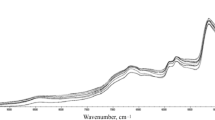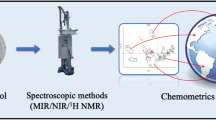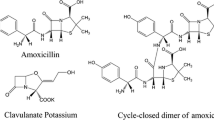Abstract
This paper presents results from an investigation into the capability of reflectance Near-Infrared (NIR) spectroscopy in the classification of pharmaceutical tablets based on their active ingredients. The part of the process selected for this study is the packaging step in the manufacture of pharmaceuticals because in older processing lines the product was classified after tablet coating and before blister packaging using visual automatic inspection techniques. However, for 100% conformance, a more discriminating technique is required. In this investigation, NIR spectra (with wavelengths between 400nm and 1100nm) were obtained for samples relating to 3 different types of pharmaceuticals: Quetiapine, Ibuprofen and Paracetamol. The dimensionality of the dataset was reduced using Principal Components and then different combinations of Principal Components were fed into a Neural Network that was configured to classify the tablets based on their active ingredients. The recognition rates achieved in this study were high enough to suggest that NIR spectroscopy is a viable method of ensuring 100% identification of pharmaceutical tablet type prior to packaging for the pharmaceuticals tested.
Similar content being viewed by others
References
Lawrence X.: Pharmaceutical quality by design: product and process development, understanding, and control. Pharmaceutical Research. 25(4), 781–791 (2008)
Patel K., Chotai N.: Pharmaceutical GMP: past, present, and future–a review. Die Pharmazie–An International Journal of Pharmaceutical Sciences. 63(4), 251–255 (2008)
Hammett R., Hunt L.: The Australian Medicines Regulatory System: A Risk-Based Approach to Regulation. Therapeutic Innovation and Regulatory Science. 43(1), 17–20 (2009)
Duong, N., Chew, M., Demidenko, S., Pham, Q., Pham, D., Ooi, M., Kuang, Y.: Vision inspection system for pharmaceuticals. IEEE Sensors Applications Symposium (SAS). 201–206, 2014
Bukovec, M., Špiclin, Ž., Pernuš, F., Likar, B.: Automated visual inspection of imprinted pharmaceutical tablets. Measurement Science and Technology. 18(9), 2921. 2007
Rajalahti T., Kvalheim O.: Multivariate data analysis in pharmaceutics: a tutorial review. International journal of pharmaceutics 417(1), 280–290 (2014)
Burns, D., Ciurczak, W. (Eds.): Handbook of Near-infrared Analysis. CRC press, Boca Raton, Florida, 2007
Blanco M., Villarroya I.: NIR spectroscopy: a rapid-response analytical tool. TrAC Trends in Analytical Chemistry. 21(4), 240–250 (2002)
Swarbrick B.: Advances in instrumental technology, industry guidance and data management systems enabling the widespread use of near infrared spectroscopy in the pharmaceutical/biopharmaceutical sector. Journal of Near Infrared Spectroscopy 22(3), 157–168 (2014)
Forcinio H.: Pharmaceutical Industry Embraces NIR Technology. Spectroscopy. 18(9), 16–19 (2003)
Durand A., Devos O., Ruckebusch C., Huvenne J.: Genetic algorithm optimisation combined with partial least squares regression and mutual information variable selection procedures in near-infrared quantitative analysis of cotton–viscose textiles. Analytica Chimica Acta 595(1), 72–79 (2007)
Hemmateenejad, B., Akhond, M., Miri, R., Shamsipur, M.: Genetic algorithm applied to the selection of factors in principal component-artificial neural networks: application to QSAR study of calcium channel antagonist activity of 1, 4-dihydropyridines (nifedipine analogous). Journal of chemical information and computer sciences. 43(4), 1328–1334, 2003
Xiaobo Z., Jiewen Z., Povey M., Holmes M., Hanpin M.: Variables selection methods in near-infrared spectroscopy. Analytica chimica acta 667(1), 14–32 (2010)
Koljonen J., Nordling T., Alander J.: A review of genetic algorithms in near infrared spectroscopy and chemometrics: past and future. Journal of Near Infrared Spectroscopy 16(3), 189–197 (2008)
Depczynski U., Frost V., Molt K.: Genetic algorithms applied to the selection of factors in principal component regression. Analytica Chimica Acta 420(2), 217–227 (2000)
Liu Y., Sun X., Ouyang A.: Nondestructive measurement of soluble solid content of navel orange fruit by visible–NIR spectrometric technique with PLSR and PCA-BPNN. LWT-Food Science and Technology 43(4), 602–607 (2010)
Carl Zeiss Jena GmbH.: MMS—Monolithic MiniatureSpectrometer. 2015, ftp://ftp.nist.gov/pub/physics/lunarproject/References/Spectrometers/ZEISS%20MMSOverview_t5U.pdf
Anonymous.: SPC220 user manual version 1.4. Australian Innovative Engineering, 90 Muirs Lane, Myrniong VIC 3341, Australia
Barnes R., Dhanoa M., Lister S.: Standard normal variate transformation and de-trending of near-infrared diffuse reflectance spectra. Applied spectroscopy. 43(5), 772–777 (1989)
Jolliffe, I.: Principal component analysis. John Wiley & Sons Ltd, 2002
Rumelhart, H., Hinton G., Williams, R.: Learning internal representations by error propagation. Nature. 323(1), 1986
The MathWorks, Inc.: MATLAB 2011 and Statistics Toolbox. Natick, Massachusetts, United States
Author information
Authors and Affiliations
Corresponding author
Rights and permissions
About this article
Cite this article
Yee, N. Principal Component Selection for Neural Network Classification of Active Ingredients from Near Infrared Spectra. Rev Socionetwork Strat 10, 91–103 (2016). https://doi.org/10.1007/s12626-016-0066-7
Received:
Accepted:
Published:
Issue Date:
DOI: https://doi.org/10.1007/s12626-016-0066-7




